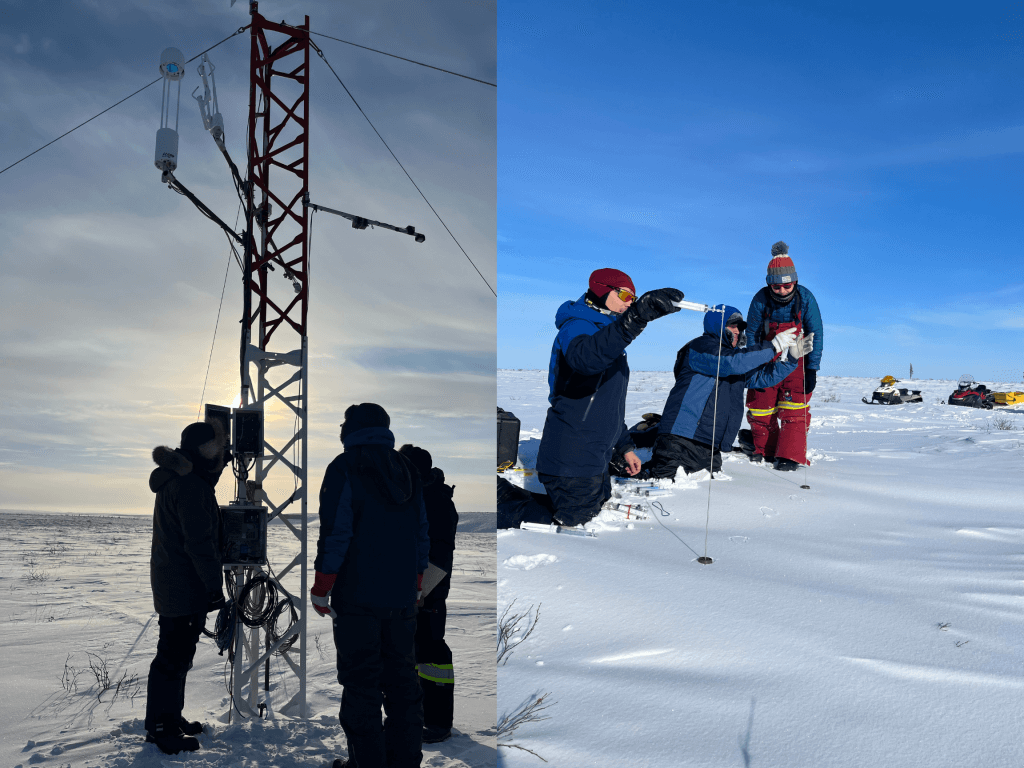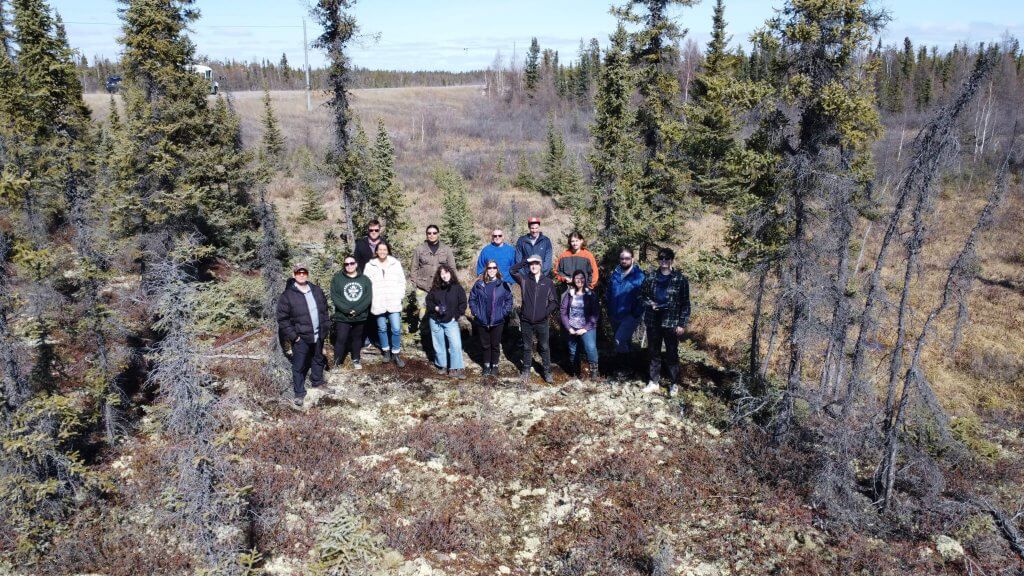
Monitoring climate change with the support of local communities in the Northwest Territories
– By Andy Vicente-Luis, Emma Riley, Elyn Humphreys, Philip Marsh, William Quinton, Oliver Sonnentag –
Arctic-boreal regions are warming rapidly, with increases in surface air temperatures over double the global average (Meredith et al., 2019). This warming leads to cascading effects on Arctic ecosystems, including loss of seasonal snow cover (Derksen & Brown, 2012), the melting of glaciers and ice sheets (Noël et al., 2018; Onarheim et al., 2018), changes in hydrologic regimes (Beel et al., 2021), shifts in vegetation dynamics (Kolk et al., 2016) and permafrost thaw (Jorgenson et al., 2006; Schuur et al., 2008).
Permafrost in Canada’s Arctic (McGuire et al., 2009; Tarnocai et al., 2009) and boreal landscapes (Walker et al., 2019; Moore et al., 2003) constitutes one of the largest stores of soil organic carbon in the world. Once thawed, previously frozen soil organic carbon becomes available for decomposition, releasing potent greenhouse gases such as carbon dioxide and methane to the atmosphere (Schuur et al., 2015). Most climate models do not take into account greenhouse gas emissions potentially released to the atmosphere by permafrost thaw, omitting a large part of the global carbon cycle. Due to the variability of greenhouse gas exchange across the Canadian Arctic-boreal region, it remains uncertain whether these vast landscapes will either enhance or mitigate the effects of climate change in the future (Schuur et al., 2015).
Continued monitoring of greenhouse gas emissions is required to understand how permafrost thaw and associated changes in forest, taiga, peatland, and tundra ecosystem composition, structure and functioning are contributing to the regional and global carbon budget. Related impacts on the hydrological cycle, local water resources and regional climate are equally important to monitor in order to better understand the interconnected response of these ecosystems to further climate change.
Over the past 15 years, Oliver Sonnentag (Université de Montréal) and collaborators Phil Marsh, William Quinton (Wilfrid-Laurier University) and Elyn Humphreys (Carleton University) have developed a network of ten micrometeorological towers worth several millions of dollars across the Northwest Territories (NT). At each tower site, we use the eddy covariance (EC) technique to quasi-continuously measure ecosystem-scale net exchange of carbon dioxide, methane, water and energy. Examining how these variables change over space and time can be used to determine how the northern land surface is interacting with the atmosphere and responding to climate change.
With the onset of the pandemic two years ago, Covid-19 disrupted critical climate change research around the world. Sonnentag and his collaborators realised how fragile their access to research infrastructure was. Travel restrictions in NT, although necessary to curb the spread of the coronavirus and protect local communities, threatened the operation of this research infrastructure and the data record used for territorial government and Indigenous community decision-making on climate change adaptation.

The continued operation of an EC tower requires regular visits by trained staff, ideally monthly, to ensure the proper functioning of the system including power supply and state-of-the-art micrometeorological instrumentation. The existing EC tower network was reliant on university researchers and technicians who had to travel to NT from southern Canada several times per year. To address these issues, a training network was developed with the help and support of academia, industry, the federal and territorial governments, and local communities across NT. This project aims to train a team of local community members living near the research sites to help maintain the micrometeorological towers. This 2-year project is supported by the Future Skills Centre (www.fsc-ccf.ca), which has a mandate to strengthen skills development networks and career opportunities in Canada.
Sonnentag and his collaborators anticipate that the training network will lead to similar local capacity-building efforts through current and future collaborations with other research projects. Local capacity-building through knowledge co-creation and co-management between communities and subject-matter experts will increase infrastructure resilience but also increase non-expert awareness and understanding of how human activities shape ecosystem health and services in an ever more complex world.
Since the project began in March 2021, we have been building the local monitoring network in NT in stages. First, a research coordinator based in Yellowknife was hired to lead the hiring efforts for 8 local community members across NT to participate in training and tower maintenance trips at research sites closest to their community.
Five fieldwork campaigns have taken place since July 2021, with varying degrees of local involvement depending on fieldwork location, weather conditions, availability and Covid-19 guidelines. These fieldwork campaigns introduced the new project members to the research site infrastructure, specifically site instrumentation, some of the procedures used for tower maintenance, as well as other climate change monitoring techniques.

Project members have participated in several training opportunities both online and in-person. A virtual course including pre-recorded videos was created to cover topics related to EC theory, EC instrumentation, fieldwork safety and other relevant topics. These videos include interviews with project members and partners, including William Quinton, Elyn Humphreys, Philip Marsh and numerous students, technicians and research associates. This material remains available to existing and new project members to help with preparation before performing fieldwork-related activities.

In-person training took place during a two-week workshop held in Yellowknife in May 2022. The first week of this workshop included safety certifications for wilderness first aid, fall protection and wildlife awareness. The second week included an introduction to various scientific techniques and theories related to EC flux measurements, scientific instrument maintenance and climate change monitoring in general. Presentations and discussions were led by industry, academic, territorial government, non-governmental organisations and Indigenous government representatives.
Community-led maintenance of the NT network of micrometeorological towers is intended to continue until March 2023 through organised site visits. Future site visits will continue to develop the scientific and technical skills of project members working towards future contract maintenance work within this network of EC towers. The success of this project is measured not only through the effective maintenance of the NT micrometeorological tower network but also through the strengthening of community partnerships, knowledge co-creation, support of the local economy and skill development in NT.
Dr. Oliver Sonnentag (he/him) is an Associate Professor and Canada Research Chair 2 in the Département de géographie (Atmosbios lab) at the Université de Montréal. Sonnentag’s research interests are in atmospheric biogeosciences in high latitudes: understanding changes in land surface – atmosphere interactions in response to rapidly changing climate and permafrost conditions, and biophysical parameter monitoring and mapping to study changes in ecosystem composition, structure and functioning. Dr. Sonnentag leads the Future Skills Centre-funded training network project.
Emma Riley (she/her) is a research coordinator in the Atmosbios lab at the Université de Montréal based in Yellowknife, NT. Riley develops and coordinates activities related to the Future Skills Centre-funded project “Climate Change Monitoring in NT” to build local micrometeorological capacity led by Dr. Oliver Sonnentag.
Andy Vicente-Luis (he/him) is a research coordinator in the Atmosbios lab at the Université de Montréal based in Montréal, QC. Vicente-Luis is responsible for the administration and science logistics in Dr. Oliver Sonnentag’s research group including the Future Skills Centre project.
Dr. Elyn Humphreys (she/her) is a Professor in the Department of Geography and Environmental Studies at Carleton University, ON. Humphreys studies the exchange of trace gases such as carbon dioxide and methane, and energy between ecosystems and the atmosphere. Her research is currently focused on the impacts of climate change and other disturbances on the carbon and energy budgets of peatland ecosystems in temperate and Arctic regions.
Dr. Philip Marsh (he/him) is a Professor and Canada Research Chair in Cold Regions Water Science in the Department of Geography and Environmental Studies at Wilfrid Laurier University, ON. The goal of Dr. Philip Marsh’s research project is to make significant advances in both the understanding of, and ability to predict, Arctic water resources at the local scale of interest to northerners. Marsh’s project uses a combination of novel field observations and experiments, remote sensing, and multiscale modelling, to provide robust scenarios of future changes in the western Canadian Arctic.
Dr. William Quinton (he/him) is an Associate Professor and Canada Research Chair in Cold Regions Hydrology in the Department of Geography and Environmental Studies at Wilfrid Laurier University, ON. Dr. Quinton also served as Director of the Cold Regions Research Centre and was a founding member of the Laurier-GNWT Partnership Agreement initiated in 2010. He has worked in the Northwest Territories since 1987 and in the Dehcho region since 1999. His research area is in hydrology of cold regions, permafrost and peatlands.
andy vicente-luis, Arctic, boreal, elyn humphreys, emma riley, fieldwork, Micrometeorology, monitoring, Northwest Territories, oliver sonnentag, philip marsh, william quinton
